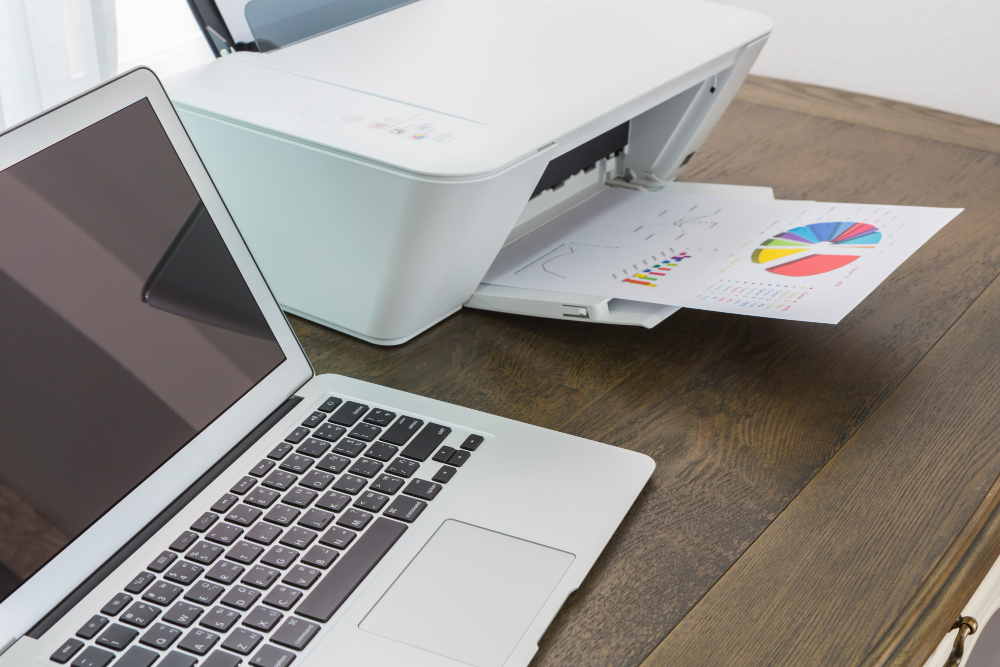Watching your printer devour expensive ink cartridges feels like feeding money directly into a shredder. If you’re wondering how to make printer cartridges last longer, you’re not alone – millions of users struggle with skyrocketing printing costs that seem to drain wallets faster than the ink drains from cartridges.
The shocking truth is that most printers waste tremendous amounts of ink through inefficient default settings, unnecessary cleaning cycles, and poor printing habits. A single cartridge that should last months often disappears within weeks, leaving frustrated users questioning whether printing at home makes financial sense.
Fortunately, simple adjustments to your printing habits and printer settings can dramatically extend cartridge life without sacrificing print quality. These proven strategies can double or even triple your cartridge lifespan, transforming printing from an expensive burden into an affordable convenience that fits any budget.
What Is Excessive Ink Consumption?
Excessive ink consumption occurs when printers use significantly more ink than necessary to produce quality output. This wasteful behavior stems from various sources, including aggressive default settings, inefficient print modes, and automated maintenance routines that consume ink without user awareness.
Modern inkjet printers are designed to prioritize print quality over ink efficiency in their default configurations. Manufacturers benefit from higher ink consumption, creating financial incentives to set printers for maximum ink usage rather than optimal efficiency. Understanding this reality helps users make informed adjustments.
Several factors contribute to rapid cartridge depletion. High-resolution settings apply more ink per square inch than most documents require. Color printing modes engage multiple cartridges even for predominantly black documents. Automatic head cleaning cycles can consume substantial ink quantities without producing any printed output.
Document types significantly impact ink consumption patterns. Photos and graphics demand more ink than text documents, while color documents naturally use more resources than black-and-white prints. Save ink printer tips become especially valuable for users who print diverse document types regularly.
Environmental conditions also affect ink usage efficiency. High temperatures can cause ink to dry faster, triggering more frequent cleaning cycles. Low humidity environments increase static electricity, potentially causing printing irregularities that waste ink through reprints and maintenance routines.
6 Essential Strategies to Make Printer Cartridges Last Longer

Tip 1: Optimize Print Quality Settings for Each Document Type
Default print settings typically use “Normal” or “High” quality modes that apply excessive ink for most everyday printing needs. Access your printer preferences through the print dialog and select “Draft” or “Fast” mode for internal documents, emails, and reference materials.
Reserve high-quality settings exclusively for important presentations, photos, or documents intended for professional distribution. This simple adjustment can reduce ink consumption by 30-50% without noticeably affecting readability for routine printing tasks.
Create custom print profiles for different document types. Most printer software allows saving preset configurations that automatically apply appropriate settings based on your document’s purpose, eliminating the need to manually adjust settings for each print job.
Tip 2: Use Grayscale Printing for Text Documents
Color cartridges deplete rapidly when printers mix colors to create “richer” black text, even in documents that appear entirely black and white. Force grayscale printing through your printer settings to ensure only black ink cartridges are used for text-heavy documents.
Many printers default to composite black (mixing cyan, magenta, and yellow) instead of pure black ink. Enabling “Black Ink Only” mode in printer preferences prevents this wasteful practice and dramatically extends color cartridge life.
This strategy proves especially valuable for printing web pages, which often contain hidden color elements like logos or backgrounds that trigger color cartridge usage even when the visible content appears monochrome.

Tip 3: Implement Strategic Font and Formatting Choices
Font selection significantly impacts printer ink saving tips effectiveness. Choose ink-efficient fonts like Times New Roman, Calibri, or Century Gothic instead of heavy fonts like Arial Black or Impact that require more ink coverage per character.
Reduce font sizes when possible without sacrificing readability. Dropping from 12-point to 11-point text can reduce ink consumption by up to 10% while maintaining professional appearance for most document types.
Avoid bold formatting unless absolutely necessary, as bold text requires multiple ink passes that substantially increase consumption. Use italic or underline formatting for emphasis when bold isn’t essential for document clarity.
Tip 4: Master Print Preview and Page Setup Options
Always use print preview before sending documents to your printer. This crucial step reveals unnecessary pages, oversized images, or formatting issues that waste ink and paper. Delete empty pages and resize graphics that exceed required dimensions.
Adjust margins to maximize content per page, reducing total page count for multi-page documents. Most documents can accommodate slightly smaller margins without affecting readability or professional appearance.
Use duplex (double-sided) printing when appropriate to reduce total paper consumption and associated ink usage. While this doesn’t directly save ink per page, it reduces total printing volume and associated maintenance cycles.
Tip 5: Maintain Optimal Printer Storage and Usage Patterns
Irregular printer usage causes ink to dry in nozzles, triggering automatic cleaning cycles that consume substantial ink without producing output. Aim to print at least one page weekly to keep ink flowing and prevent costly maintenance routines.
Store your printer in stable temperature and humidity conditions. Extreme temperatures or dry air accelerate ink drying and increase cleaning cycle frequency. Maintain room temperatures between 60-80°F with moderate humidity levels.
When planning extended periods without printing, print a nozzle check pattern before shutting down. This ensures all cartridges are functioning properly and prevents dried ink problems that require intensive cleaning upon restart.

Tip 6: Utilize Ink-Saving Software and Driver Features
Many printer manufacturers offer eco-friendly printing modes specifically designed to extend cartridge life without significantly compromising output quality. Enable these modes through printer properties or dedicated software utilities.
Third-party ink-saving software can reduce consumption by intelligently adjusting print density, removing unnecessary graphics, and optimizing color usage. Programs like GreenPrint or PrintEco provide detailed control over ink usage patterns.
Update printer drivers regularly to access the latest efficiency features and bug fixes that may reduce unnecessary ink consumption. Manufacturers periodically release driver updates that include improved ink management algorithms.
Advanced Tools and Professional Insights
Professional print management becomes crucial for businesses seeking to maximize printer ink saving tips effectiveness across multiple devices and users. Print management software provides detailed usage analytics that identify wasteful printing patterns and opportunities for improvement.
Ink level monitoring tools help predict cartridge replacement needs, preventing emergency purchases of expensive retail cartridges. Many third-party utilities provide more accurate ink level readings than built-in printer software, enabling better planning and bulk purchasing opportunities.
HP’s Smart Printing website offers comprehensive resources for optimizing print efficiency, including model-specific settings guides and advanced configuration options that aren’t available through standard printer interfaces.
Consider investing in high-yield cartridges for printers with heavy usage patterns. While these cartridges cost more initially, they provide significantly better cost-per-page ratios and require less frequent replacement, reducing both expenses and maintenance interruptions.
Cartridge recycling programs from major manufacturers often provide discounts on replacement cartridges while supporting environmental sustainability. These programs can reduce long-term printing costs while promoting responsible disposal practices.
Common Mistakes That Waste Ink and Money
Many users unknowingly engage in practices that dramatically increase save ink printer tips necessity through wasteful habits and misconceptions. Printing unnecessary copies “just in case” multiplies ink consumption without providing real value. Implement digital document sharing and storage to reduce physical printing needs.
Using photo paper for non-photo documents wastes both expensive paper and extra ink, as photo papers are designed to absorb more ink for enhanced color reproduction. Reserve specialty papers for their intended purposes and use standard copy paper for routine printing.
Ignoring low ink warnings until cartridges are completely empty triggers emergency replacement scenarios where users pay premium prices for immediately available cartridges. Monitor ink levels proactively and purchase replacements during sales or through bulk purchasing programs.
Automatic printer maintenance cycles often run more frequently than necessary, especially on printers that see irregular use. Disable automatic cleaning cycles and run them manually only when print quality issues become apparent, rather than following predetermined schedules.
Printing entire web pages without editing captures advertisements, navigation menus, and other unnecessary elements that consume ink without providing value. Use browser print preview features to select only relevant content sections before printing.
Leaving printers in standby mode for extended periods can trigger unnecessary maintenance cycles. Power off printers completely during long periods of non-use, but remember to print test pages before important jobs after extended downtime.
Frequently Asked Questions
How much can these tips actually save on ink costs? Implementing all six strategies typically reduces ink consumption by 40-60%, translating to hundreds of dollars in annual savings for moderate to heavy printer users. Individual results vary based on printing habits and document types.
Will using draft mode significantly reduce print quality? Draft mode produces perfectly readable text for most internal documents while using 30-50% less ink. Reserve higher quality modes for presentations, client-facing documents, and materials requiring professional appearance.
Is it worth buying compatible cartridges to save money? High-quality compatible cartridges can provide 50-70% cost savings compared to genuine cartridges while delivering comparable performance. Research reputable suppliers and read reviews to ensure quality and reliability.
How often should I print to prevent ink from drying out? Print at least one page per week to maintain ink flow and prevent nozzle clogging. This small investment in maintenance printing prevents expensive cleaning cycles and ensures reliable performance when you need it.
Conclusion
Learning how to make printer cartridges last longer transforms printing from an expensive necessity into an affordable convenience. These six proven strategies can double or triple cartridge lifespan while maintaining the print quality you need for important documents and projects.
The key to success lies in understanding that small changes in printing habits create dramatic long-term savings. Optimizing settings for each document type, choosing efficient fonts, and maintaining regular usage patterns prevent waste while ensuring reliable printer performance when you need it most.
Remember that the most effective approach combines multiple strategies rather than relying on single solutions. By implementing these extend cartridge life techniques systematically, you’ll enjoy significant cost savings while reducing environmental impact through decreased cartridge consumption. Start with the easiest adjustments and gradually incorporate more advanced strategies as they become habitual, creating a sustainable approach to affordable, efficient printing.
Printer Error Codes Fix: Decode & Solve Any Error Instantly Read More.




